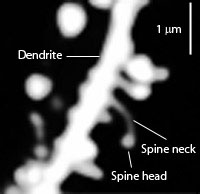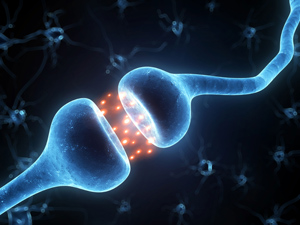|
|
Fragile X in mice responds to experimental drugs
Fragile X Syndrome (FXS) is an inherited cause of intellectual disability, especially in boys. Cognitive impairment in neuro-developmental disorders like FXS is thought to be due to changes in the brain which alter synaptic connections.
It results range from mild to severe, with physical characteristics such as an elongated face, large or protruding ears, and large testes. Behaviors include repetitive, purposeless movements such as hand-flapping, and social anxiety. Previous research suggests a specific protein in the hippocampus — known as the "seat" of learning and memory — did not migrate to the appropriate hypocampal spot in mouse models of FXS mice, versus what is found in wild-type (or normal) mice.
Image of synapse between dendritic spines Wikipedia |
|
|
Luis Martinez, a pharmacology doctoral candidate at the University of Houston College of Pharmacy, working in the lab of associate professor Maria V. Tejada-Simon, will present the labs' latest findings in the FXS autism-linked genetic disorder.
The Tehada-Simon lab researches the role of Rac or Ras-related C3 botulinum toxin substrate 1, a protein found in human cells and encoded by the RAC1 gene, in Long-term potentiation (LTP) - which indicates the increase in strength of synapses stimulated in the CA1 area of the hippocampus.
Human Hippocampus
Wikipedia |
|
|
Previously the laboratory found Rac is highly expressed in the adult mouse hippocampus where it might be cycling between inactive and active forms. The lab found Rac appears during fear learning in the hippocampus of the adult mouse. Currently they are investigating whether it plays a role in all signals associated with learning and memory.
A second aspect of their research is related to mental retardation (MR). Precise synaptic connectivity is essential for normal brain function, the most common neuropathologies (or diseases found in nervous system tissue) are associated with MR due to abnormal dendritic spine shape. Although abnormalities in dendrites and spines are associated with impaired cognitive ability, how abnormalities are generated is not well understood.
To understand the mechanisms leading to loss of synapse, current evidence points to small GTPase-linked genes. GTPases are a large family of enzymes which act on amino groups. They bind to and increase the rate of chemical reaction (hydrolyze) to guanosine triphosphate (GTP). GTP helps synthesize RNA during DNA replication by cleaving chemical bonds and increasing water in the G domain, common to all GTPases. Errors in cleaving chemical bonds may lead to neuronal micro-construction errors in the dendrite spine found in cognitive disorders.
Work by Tejada-Simon's and other labs, has found that the Rac1 (protein) plays an important role in synapse formation. An abnormally high number of synapses occur in FXS model mice from newborn to juvenile.
|
|

 Common shapes of dendritic spines. Common shapes of dendritic spines.
Image credit: Wikipedia
|
"During their development and growth into juvenile stage, the FXS mouse model - in which Rac1 expression is up-regulated (or increased) - fail to 'prune' surplus neural synapse connections.
"Yet, we found that pharmacologically inhibiting Rac1 to prevent its activation, we were able to rescue cognitive function to improve their learning and memory skills."
Luis Martinez, Pharmacology Doctoral Candidate at the University of Houston College of Pharmacy.
Following peer review of Martinez's poster abstract submission, titled "Correcting memory deficits in Fragile X syndrome by targeting Rac1/PAK1 signaling," he was invited to also present their findings at the Julius Axelrod Symposium, New Vistas on Drug and Gene Therapies of Cognitive Deficits in Down Syndrome, Autism, Leucodystrophies and Alzheimer's Disease.
The symposium oral presentation and the poster presentation sessions are both part of the American Society for Pharmacology and Experimental Therapeutics' annual meeting, held in conjunction with the Experimental Biology conference.
Poster to be presented Sun. 9:00 am— San Diego Convention Center, Exhibit Halls A-D
Neuropharmacology
Drug Discovery and Development
Presentation time: 12:30 pm–2:30 pm
A42 707.8 Correcting Memory Deficits in Fragile X
Syndrome by Targeting Rac1/PAK1 Signaling. L. Martinez,
M.V. Tejada-Simon. Univ. of Houston.
FASEB is composed of 30 societies with more than 125,000 members, making it the largest coalition of biomedical research associations in the U.S. The organization's mission is to advance health and welfare by promoting progress and education in biological and biomedical sciences through service to its member societies and collaborative advocacy.
About the University of Houston
The University of Houston is a Carnegie-designated Tier One public research university recognized by The Princeton Review as one of the nation's best colleges for undergraduate education. UH serves the globally competitive Houston and Gulf Coast Region by providing world-class faculty, experiential learning and strategic industry partnerships. Located in the nation's fourth-largest city, UH serves more than 42,700 students in the most ethnically and culturally diverse region in the country. For more information about UH, visit the university's newsroom at http://www.uh.edu/news-events/.
About the UH College of Pharmacy
For more than 65 years, the University of Houston College of Pharmacy (UHCOP) has shaped aspiring pharmacists, scientists and researchers. The college offers graduate degrees in pharmacy administration, pharmacology and pharmaceutics, a professional pharmacy degree, combined professional/graduate degrees, and post-graduate residency and fellowship programs. With facilities on the UH campus and in the Texas Medical Center, the UHCOP is accredited by the Accreditation Council for Pharmacy Education.
To receive UH science news via email, sign up for UH-SciNews at http://www.uh.edu/news-events/mailing-lists/sciencelistserv/index.php.
Return to top of page
|
|
|
Apr 4, 2016 Fetal Timeline Maternal Timeline News News Archive

Image Credit: Public Domain
|
|
|
|




.jpg)


